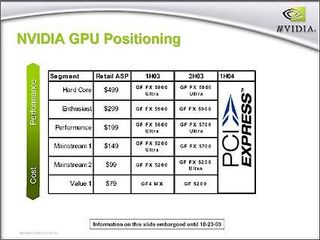THG Graphics Card Buyer's Guide
Budget (Card Overview)

Each graphics chip maker develops products for every price category. Pictured here is NVIDIA's roadmap from the year 2003.
Cards can generally be categorized into three large groups, each of which can once again be subdivided into two subgroups. The two big graphics chip companies, ATI and NVIDIA, offer different chips for each of the various price brackets. Note that the boundaries between the categories tend to blur quite a bit, however, due to price fluctuations in the market.
The three main price groups are the entry-level or budget line, the mid-priced or mainstream products, and finally, the higher-end enthusiast cards. Again, within each of these there are two versions offering different performance levels - one is the standard version, while the other runs at higher clock speeds. ATI denotes these faster cards by the addition of a "Pro" or "XT" to the card name, while NVIDIA's nomenclature uses the "GT" and "Ultra" suffixes.
Low-cost products are often tagged as SE or LE parts. However, these budget cards sometimes don't carry any special tag at all, making them hard to tell apart from "the real deal". In these cases, only careful attention to the technical data will help you from mistakenly purchasing the wrong card.
NVIDIA is a chipmaker only, focusing its attention solely on designing and producing graphics processors, while leaving the production and sale of retail cards to its board partners. ATI, on the other hand, is quite active in the retail market as well, albeit only in the United States and Canada. Its cards are usually designated "Built by ATI", while those produced and sold by other companies are "Powered by ATI."
Another factor further complicating any attempt to categorize the cards by price alone are the graphics cards from older generations, which keep getting cheaper due to the introduction of newer models. There are especially pronounced differences between NVIDIA and ATI here. ATI's second to last generation of chips (Radeon 9500, 9700, 9800) is still very much up-to-date from a technological perspective, with DirectX 9 support and multisampling FSAA. Only the Radeon 9000 and 9200 cards are the exception here, as they are still based on the DirectX 8 design of the Radeon 8500 along with its slower super sampling FSAA implementation. Shader Model 3.0 is not supported by any ATI card at this point. The only cards that actually can take advantage of it are those of NVIDIA's GeForce 6xxx line.
In contrast, NVIDIA's second to last generation of cards are, by today's standards, technologically outdated (DirectX 8 and multi sampling FSAA on the GeForce 4 Ti, DirectX 7 on the GeForce 4 MX). The last iteration of the GeForce FX 5xxx series performed very well in DirectX 8 titles, but drops to mediocre levels in current DirectX 9 games. As mentioned before, this weakness has been corrected in the new GeForce 6xxx line (note the absence of the "FX" designation).
Stay on the Cutting Edge
Join the experts who read Tom's Hardware for the inside track on enthusiast PC tech news — and have for over 25 years. We'll send breaking news and in-depth reviews of CPUs, GPUs, AI, maker hardware and more straight to your inbox.
Most Popular

